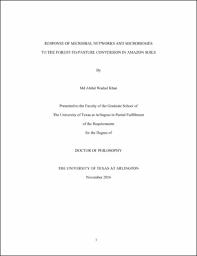| dc.description.abstract | The Amazon rainforest is the largest tropical rainforest ecosystem in the world, and an extremely important region ecologically. Due to the growing human needs mainly for cattle ranching and cultivation, the rainforest has been in the process of clearing since 1970s losing an average of 25,000 km annually. This ecosystem conversion has a substantially adverse impact on biological diversities, in which the response of microbial diversity has not been studied until recently. Several studies showed that the conversion severely altered microbial diversities, with an increased alpha and decreased beta diversities. Given that microorganisms are closely associated with soil-associated functions, where microbial interactions are important in addition to diversity, I attempted to explore the spatial pattern of microbial co-occurrence networks based on the relative abundance of microbial species. Moreover, I used metagenomes to analyze differential abundances of metabolic processes related to ecosystem functioning. The taxonomic (16S rRNA) and functional gene datasets were obtained from Amazon forest and pasture soils. The analyses showed that forest-to-pasture conversion altered network topological properties, with decreases in the number of nodes and edges, average connectivity, betweenness centrality, and in-degree. My results also revealed that network topological patterns across ecosystem, and topological roles of major bacteria taxa differed significantly between forest and pasture, indicating substantial alteration of relationship pattern between different bacterial taxa. I estimated this pattern, which may discern lifestyle strategies of species, and syntrophy between species, critical for adaptation. For example, higher co-occurrence of Alphaproteobacteria and Nitrospirae, known to have members involved in nitrification and denitrification processes, in forest soils may indicate higher reliance on nitrogen metabolism for energy harvest. Consistent with the taxonomic shifts, functional genes of forest soils showed a similar pattern of metabolic pathways involved in nitrogen cycle, whereas the pasture microbiome had increased abundance of genes involved in methanogenesis and fermentation. Conversely, forest microbiomes had higher relative abundance of genes involved in the TCA cycle and oxidative phosphorylation. With the survey of taxonomic and functional diversities, this study sheds light on how the anthropogenic activities impact on co-occurrence and ecosystem functioning. Our approach, however, requires further validation, and approaches such as multi-omics, cultivation and lab experiments should be integrated for better understanding of soil-associated functions in these ecosystems. | |


